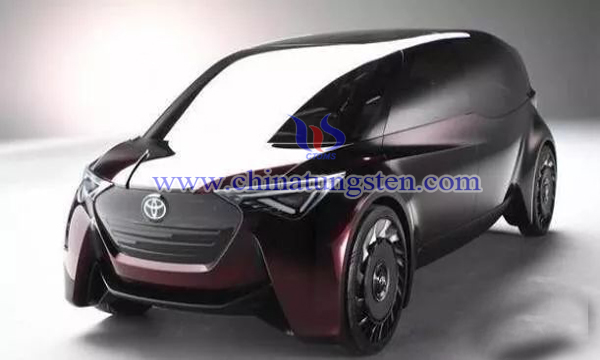New Breakthrough in Fuel Cell Research and Development
- Details
- Category: Tungsten's News
- Published on Saturday, 02 June 2018 15:20
At the Tokyo auto show, TOYOTA, Honda and NISSAN, the three major Japanese auto makers, exhibited a number of new energy vehicles, both fuel cell vehicles. Why are the Japanese still bigoted to develop fuel cell cars?

Compared to current pure electric vehicles, fuel cells are truly clean energy sources. Even at present high hydrogen production costs, many developed countries have not given up their research. In the field of hydrogen energy research, Japan, Europe and the United States have good scientific research results and technology accumulation. Recently, Europe has made better performance and price. The lower fuel cell catalysts are mainly tungsten oxide and cobalt. The low cost of hydrogen production is only a matter of time.
The Tokyo auto show is known as one of the world's five largest auto show. As the world's major automobile manufacturing country, the auto show is also the vane of the future trend of automobile development in addition to the new car exhibition. The Tokyo auto show is undoubtedly the best choice to observe the future development trend of the Japanese car enterprises. As a well deserved pioneer in the automobile industry, the TOYOTA believes that the development of hydrogen fuel cells is more conducive to environmental protection. At the Tokyo auto show, two of TOYOTA's 7 global first launch vehicles were driven by hydrogen fuel, the fuel cell luxury car Fine-Comfort Ride and the fuel cell bus SORA introduced at the 2020 Tokyo Olympic and Paralympic Games.
Honda agreed with TOYOTA's concept and spent enough research and development on hydrogen fuel cells. Its Clarity new energy vehicle is the world's first development of hydrogen fuel cell, plug-in mixing and pure electric three powertrain versions. However, Musk, a CEO of luxury electric vehicle brand Tesla, has objected that the model is very stupid. From the scene, the new energy vehicles are divided into two camps, while most manufacturers develop lithium batteries as power units, while the Japanese and Korean cars, represented by TOYOTA and Honda, are developing fuel cell vehicles.
Under the guidance of the government, Japan has built 99 hydrogen stations. By 2020, the number of hydrogen stations will increase to 160. TOYOTA's first hydrogenation station in China was formally completed, and TOYOTA began to start a demonstration experiment in the FCEV "MIRAI future" in China. The new achievements on fuel cell research in the world have also brought more confidence to Japanese enterprises in the recent world. In the future, if the TOYOTA led hydrogen fuel cell vehicle can be produced, it will solve the problem of the integration of the new energy vehicles in China.
There is a close relationship between fuel cells and tungsten. Tungsten based catalysts are very likely to be used in future universal fuel cells. This view has been widely recognized in Japan, the European Union and other developed countries. Recently, the Catalonia Institute of chemistry announced a new cheap and efficient fuel cell catalyst.
Chemists discovered a compound composed of cobalt and tungsten (technically known as polyoxometalate), which is better than iridium catalyzed water decomposition. The researchers think: nanoscale tungsten and cobalt have very large activity and multi molecule function, and polyoxometalate is cheaper than iridium, so that we can work in acid medium. The best medium is the catalyst for producing oxygen, which is really a highly efficient combination catalyst.
The researchers explained: water molecules make hydrogen energy cleaner, but it is not easy. Now we have finally found a cheaper and more efficient catalyst that will enable us to get hydrogen at a competitive price. The best catalyst is based on the iridium oxide, but iridium is a very expensive and rare precious metal. Moreover, the advantage of the new catalyst is that the tungsten cobalt catalyst is particularly effective at low power consumption. This is an advantage. It can save electricity and enable us to decompose the energy needed for water from renewable energy sources such as solar panels.
The market competition of new energy vehicles will become more and more fierce. In order to occupy a place, it is necessary to increase the investment of the capital. The Kobe iron and steel event makes Japanese manufacturing take the altar, but the technical force of Japan can not be overlooked. In some cases, the success of the Japanese comes from his persistence and bigotry for the target. The new energy vehicle market will be the game between pure electric vehicle type and hydrogen fuel cell. We can wait and see who can laugh to the end and occupy the market.
Copyright statement: This article is used only for the China Tungsten Industry Association and China Tungsten online. Any individual without written permission or without the copyright and the source is not allowed to copy or reprint without authorization. Otherwise, this website will be regarded as a tort, and the website will be investigated for its legal responsibility.
- Tungsten Manufacturer & Supplier, Chinatungsten Online: www.chinatungsten.com
- Tungsten News & Prices of China Tungsten Industry Association: www.ctia.com.cn
- Molybdenum News & Price: news.molybdenum.com.cn
- Tel.: 86 592 5129696; Fax: 86 592 5129797; Email: sales@chinatungsten.com